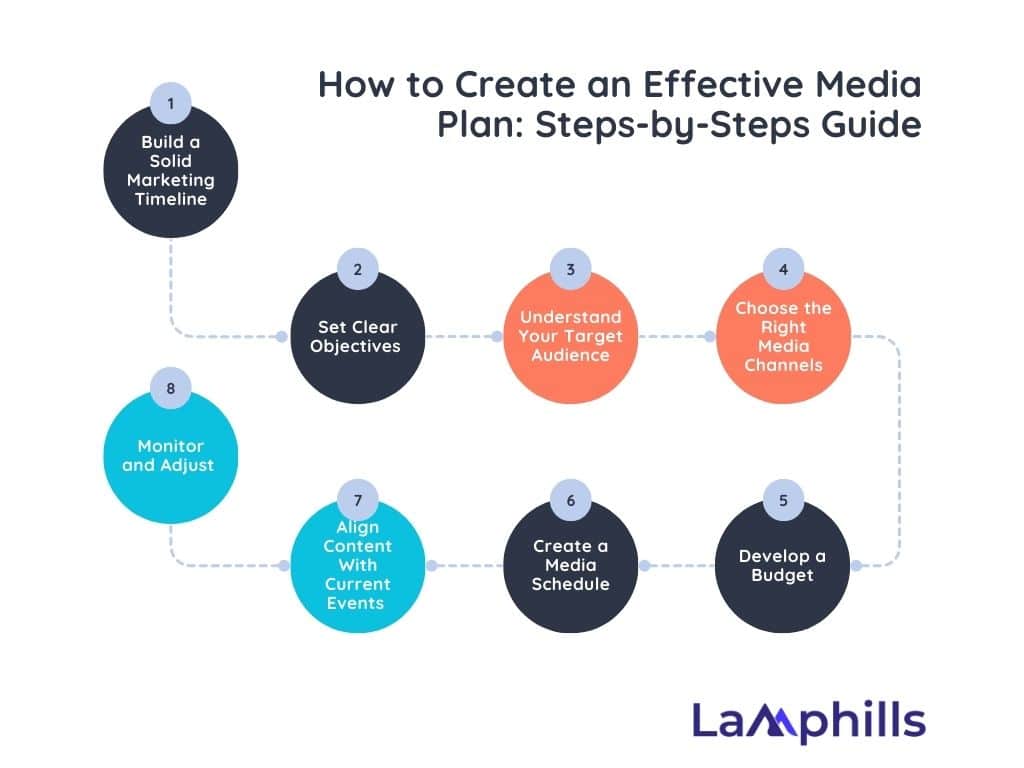I’ve seen firsthand how a well-structured media plan can make or break a campaign in marketing. It’s no longer just about placing ads and hoping for the best—today, it’s about precision, strategy, and adaptability. It’s also about using creativity to create an effective media plan. Businesses with a detailed media plan are significantly more likely to hit their marketing goals, often by as much as 30%.
In this guide, I’ll walk you through the exact steps I’ve used to create successful media plans for a range of clients—from small businesses just getting off the ground to established brands looking to optimize their efforts. By the end, you’ll have a clear roadmap and a ready-to-use template to help you confidently plan your next campaign.
Key Points
- Businesses with a detailed media plan are significantly more likely to hit their marketing goals, often by as much as 30%.
- A media plan is your strategic blueprint for delivering the right message to the right audience at the right time and through the right channels.
- Creating an effective media plan is about choosing the right channels, setting clear objectives, deeply understanding your audience, and being willing to adjust your strategy as you go.
- Data and analytics have their role and usefulness in media planning, but, creativity is what truly sets successful campaigns apart.
What is a Media Plan?
A media plan is your strategic blueprint for delivering the right message to the right audience at the right time and through the right channels. It’s about more than just scheduling ads; it’s about ensuring every dollar you spend moves you closer to your marketing objectives.
Let’s say you’re running a campaign to promote a new product. Without a media plan, you might scatter your ads across different platforms without much thought. But with a media plan, you strategically select channels based on where your audience spends their time, allocate your budget to get the most impact, and schedule your ads to maximize reach and engagement.
Types of Media Planning
The primary types of media planning are traditional and digital media planning. There’s a third one though, hybrid, which combines traditional and digital media planning. However, types of media planning have varying responses. Many believe that earned, paid, and owned media are the main types of media planning, however, I think we should use classification instead of types to categorize media planning. Based on this, let’s see the classifications of effective media planning:
#1. Traditional Media Planning
Traditional media planning involves selecting and buying space or time in conventional media channels such as television, radio, print (newspapers and magazines), and outdoor advertising (billboards, posters). This type of media planning has been the cornerstone of advertising for decades.
#2. Digital Media Planning
Digital media planning focuses on online platforms such as social media, search engines, websites, email, and mobile apps. With the rise of the internet and mobile technology, digital media planning has become increasingly important.
#3. Cross-Media Planning (Hybrid Approach)
Cross-media planning, also known as a hybrid approach, integrates traditional and digital media strategies to create a cohesive marketing campaign that leverages the strengths of each medium.
#4. Paid Media
Paid media refers to any form of media that you pay for to promote your content or brand. This includes advertising on various platforms, whether traditional (like TV ads, print ads, and radio spots) or digital (such as pay-per-click ads, social media ads, and display ads). Paid media is often the cornerstone of a media plan, providing immediate reach and visibility. It can be precisely targeted in digital media planning and is essential for driving traffic and generating leads.
#5. Owned Media
Owned media refers to the channels and platforms that your brand controls. This includes your website, blog, social media profiles, email newsletters, and any content you create and manage directly. Owned media is central to building a long-term relationship with your audience. It’s where you can control the message, create content, and foster engagement. In media planning, owned media is used to nurture leads generated through paid media and to maintain ongoing communication with customers.
#6. Earned Media
Earned media is any free publicity that a brand gains through word-of-mouth, customer reviews, social shares, mentions in the press, or other organic means. It’s often seen as the result of successful paid and owned media efforts. Earned media is a valuable outcome of effective paid and owned media strategies. It amplifies your message without additional cost and adds credibility. Media planners often aim to maximize earned media by creating shareable content and fostering positive customer experiences.
How to Create an Effective Media Plan: Steps-by-Steps Guide

Below is a step-by-step guide on how to create an effective media plan:
#1. Build a Solid Marketing Timeline
A well-structured marketing timeline is the backbone of any successful campaign. When planning a new product launch or a promotional event, I always start by mapping out a detailed timeline. This timeline includes everything from initial research and content creation to distribution and post-campaign analysis.
What I’ve learned is that timing is everything. Each stage of your campaign needs enough time to develop properly. For instance, market research shouldn’t be rushed—giving it ample time ensures that your messaging is on point and resonates with your target audience. Over the years, I’ve seen how a well-paced timeline keeps the team on track. It also optimizes the campaign’s effectiveness.
#2. Set Clear Objectives
In my experience, the success of any media plan starts with setting clear, measurable objectives. This is where many businesses trip up—they either set goals that are too vague or too ambitious without a realistic path to achievement.
A good objective is SMART: Specific, Measurable, Achievable, Relevant, and Time-bound. For example, instead of saying “increase sales,” a SMART objective would be “increase online sales by 20% within three months by targeting new customers through social media ads.” This clarity gives your entire team a focused goal to work towards.
#3. Understand Your Target Audience
Understanding your audience isn’t just about knowing their age or location. It’s about digging deeper into their behaviors, preferences, and needs. This is where creating detailed audience personas can make a huge difference.
When creating media plans, I mostly spend time researching the target audience. I look at data from previous campaigns, analyze customer feedback, and use tools like Google Analytics and social media insights to understand who I’m targeting. For example, if I’m targeting millennials interested in sustainable fashion, I focus my efforts on platforms like Instagram and eco-conscious blogs that resonate with this demographic.
#4. Choose the Right Media Channels
One of the things you must avoid is overlooking the right media channels. Over the years, I’ve learned that not all platforms are created equal—what works for one campaign might not work for another. The key is to align your channel selection with where your audience is most active.
For instance, if you aim to reach a younger, tech-savvy audience, platforms like Instagram, TikTok, and YouTube are your best bets. On the other hand, if you’re targeting professionals, LinkedIn and email newsletters might yield better results. It’s about meeting your audience where they are with the message that resonates.
#5. Embrace Content Batching for Efficiency
One of the game-changing techniques I’ve adopted is content batching. Instead of creating content sporadically, I set aside specific days to focus solely on content production. This approach allows me to channel all my creative energy into generating a batch of content that can be rolled out over time, rather than scrambling at the last minute.
#5. Develop a Budget
Budgeting is often where the rubber meets the road in media planning. In my experience, an effective budget isn’t just about how much you spend, but how strategically you allocate those funds.
I always recommend starting with a clear understanding of your overall budget and then breaking it down by channel based on your objectives and the potential ROI of each channel. For example, in a campaign with a $10,000 budget, I might allocate 40% to digital ads, 30% to influencer marketing, 20% to social media, and 10% to traditional media. However, I always leave room for flexibility. I’m willing to reallocate funds to more effective areas if a particular channel isn’t delivering as expected.
#6. Create a Media Schedule
Timing is everything in media planning. I’ve seen campaigns succeed or fail based on how well their media schedule was timed. The key is to think strategically about when and how often your ads should run.
For example, if you’re promoting a seasonal product, your media schedule should ramp up ads in the weeks leading up to the peak season. Similarly, if your audience is primarily active on social media during evenings and weekends, that’s when your ads should be live. A well-timed schedule ensures that your message reaches your audience when they’re most receptive.
#7. Align Content with Current Events
Incorporating current events into your content strategy is a powerful way to make your brand feel timely and relevant. However, it’s a delicate balance—you want to capture attention without appearing opportunistic. Over the years, I’ve had great success by carefully selecting events or trends that align with the brand’s values and audience interests.
For instance, I once tied a campaign to a major national holiday, crafting content that resonated deeply with the audience by connecting the brand’s message to the spirit of the day. This increased engagement and strengthened the brand’s connection with its community. The key is to be genuine and thoughtful in relating your content to current events.
#8. Monitor and Adjust
One of the biggest mistakes I’ve seen in media planning is setting it and forgetting it. A successful media plan is a living document that requires constant monitoring and adjustment.
Using tools like Google Analytics, Facebook Insights, and other performance-tracking software, I continuously monitor the effectiveness of each element of the media plan. If something isn’t working, I’m quick to pivot. For instance, if I notice that my Facebook ads aren’t performing as well as anticipated, I might shift more budget towards Instagram or Google Ads where I’m seeing better engagement.
How to Create an Effective Media Plan: Importance of Creativity in Media Planning
To create an effective media plan, you need creativity. Although data and analytics have their role and usefulness, creativity is what truly sets successful campaigns apart. The following are some of the reasons why creativity should be the center of your effective media plan:
#1. Capturing Attention
Creativity is what grabs the audience’s attention. A unique, well-crafted message can cut through the noise and make your brand stand out. For instance, creative storytelling in a video ad can evoke emotions and create a memorable experience that resonates with viewers.
#2. Building Brand Identity
Creative media plans help build and reinforce your brand identity. Whether through a consistent visual style, a distinctive tone of voice, or a clever campaign theme, creativity ensures the audience recognizes and relates to your brand.
#3. Engagement
Creativity drives engagement by encouraging interaction. Interactive ads, gamified experiences, or user-generated content campaigns are just a few examples of how creativity can invite your audience to participate, rather than passively consume your message. Engaged audiences are more likely to become loyal customers.
#4. Problem-Solving
Creative media planning also involves finding innovative solutions to challenges, such as limited budgets or difficult-to-reach audiences. For example, a guerrilla marketing campaign might be a creative way to generate buzz without the need for a large budget.
#5. Adapting to Trends
The media landscape keeps evolving, and creativity allows your brand to stay relevant by adapting to new trends. Whether it’s tapping into the latest social media craze or responding to cultural moments, creative media planning keeps your brand in the conversation.
How to Create an Effective Media Plan: Planning Tools for Small Businesses
Small businesses often operate with limited budgets, making it essential to choose media planning tools that offer the best value for money. Secondly, the right media planning tool depends on your needs and goals. These tools can help small businesses plan and execute effective media campaigns without breaking the bank. The following are some top media planning tools that can help you maximize your budget:
- Marketing Analysis Tools
- Research tools
- Demand-side platforms
- Competitive analysis tools
Real-World Examples of Effective Media Plans
The following are some renowned examples of effective media plans:
#1. Nike’s “Just Do It” Campaigning
Objective: To increase brand awareness and drive sales among young athletes.
Strategy: Nike leveraged a mix of digital and social media platforms, focusing on Instagram and YouTube to reach their target audience. They also collaborated with influencers and athletes, which added authenticity to their message.
Result: This strategy boosted sales and also solidified Nike’s position as a brand that champions individual athleticism and perseverance.
#2. Coca-Cola’s Share a Coke Campaign
Objective: Enhance consumer engagement and boost sales.
Strategy: Coca-Cola personalized their products by printing popular names on bottles, creating a buzz on social media as consumers searched for their names. They used traditional media (TV, billboards) and digital platforms (social media, influencer marketing) to achieve their objective..
Result: The campaign was a huge success, driving significant increases in sales and social media engagement.
Lamphills Free Media Plan Template
Creating a media plan from scratch can be overwhelming, especially if you’re new. That’s why I’ve developed a free, customizable media plan template. This template will help you organize your objectives, audience insights, budget allocation, and media schedule—all in one easy-to-use document.
Download Lamphills Free Media Plan Template
How to Create an Effective Media Plan: Legal and Ethical Considerations
Media planning is not just about reaching the right audience; it’s also about doing so legally and ethically. Generally, this protects your brand and builds long-term trust with your audience. The following are some key considerations to keep in mind when creating your next plan:
- Advertising regulations
- Privacy laws
- Transparency in media buying
- Ethical targeting
Conclusion
Creating an effective media plan is about choosing the right channels. It’s also about setting clear objectives, deeply understanding your audience, and being willing to adjust your strategy as you go. With the right plan, you’ll reach your target audience and also maximize your marketing ROI. So, use the steps and resources in this guide as your foundation, and you’ll be well on your way to creating an effective media plan that drives real results.
Related Articles
- Earned Media Value Explained: Why It Matters and How to Calculate It
- Creating a Winning Media Plan: A Step-by-Step Guide
- Paid vs. Organic Search: Which Strategy is Right for You?
- Earned Media Strategy: Proven Tips for Implementation 2024






